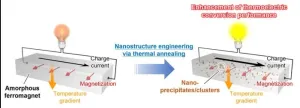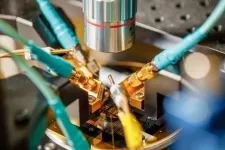(Press-News.org) Extreme exercise doesn’t seem to shorten the lifespan as is widely believed, suggest the findings of a study on the longevity of the first 200 athletes to run a mile in under 4 minutes, and published online in the British Journal of Sports Medicine.
They outlive the general population by several years, shows the study, which marks the 70th anniversary of the seminal achievement of Roger Bannister, who was the first person to run a mile in under 4 minutes in May 1954.
While regular moderate exercise is considered a pillar of healthy ageing, it has long been thought that exposing the body to bouts of extreme endurance exercise may push it too far and shorten life expectancy, say the researchers.
The repeated bouts of near maximal to maximal exercise performed by mile runners makes them a unique group in which to test the potential impact of extreme intense exercise on longevity, they explain.
They therefore scrutinised the compendium of 1759 athletes who had run a mile in under 4 minutes as of June 2022, and extracted the details of the first 200 to do so, on the grounds that they would be at an age that would either match or exceed the typical life expectancy for their generation.
The runners’ longevity was tracked, using publicly available information, from the exact date of their first successful attempt at breaking the 4-minute mile to either the age of 100, the end of 2023, or death, to find out the average difference in life expectancy between them and the general population, matched for age, sex, and nationality.
This difference was calculated as the observed life years for a runner minus their population-matched life expectancy. This number was then averaged across all 200.
The first 200 runners to break the 4-minute mile spanned a period of 20 years from 1954 to 1974. They came from 28 different countries across Europe (88), North America (78), Oceania (22) and Africa (12).
They were born between 1928 to 1955, and were aged 23, on average, when they ran the mile in under 4 minutes, with times ranging between 3:52.86 and 3:59.9 minutes.
Of the total, 60 (30%) had died and 140 were alive at the time of the analysis. The average age at death was 73, but ranged from 24 to 91, while the average age of the surviving runners was 77, ranging from 68 to 93.
Information on cause of death wasn’t known for most of the athletes, but of the seven who died before the age of 55, six were due to trauma or suicide and one was due to pancreatic cancer.
The analysis revealed that the under 4-minute milers lived nearly 5 years beyond their predicted life expectancy, on average, based on sex, age, year of birth, age at achievement, and nationality.
When factoring in the decade of completion, those whose first successful attempt was in the 1950s, lived an average of 9 years longer than the general population during an average tracking period of 67 years.
And those whose first successful attempt was in the 1960s and 1970s lived 5.5 years and nearly 3 years longer during an average tracking period of 58 and 51 years, respectively.
General improvements in life expectancy secondary to advances in the diagnosis and treatment of several major diseases might explain this particular trend, suggest the researchers.
They acknowledge that they didn’t have any information on the lifelong exercise habits (or other health behaviours) of the 200 athletes included in the study, so weren’t able to determine the precise relationship between lifelong exercise dose and longevity.
And comparison against the general population precluded assessment of how other lifestyle factors, such as diet and smoking, cardiometabolic risk factors, and other potentially influential medical factors, such as high blood pressure and high cholesterol, might affect longevity. Finally, the study included only men as no woman has yet to run a mile in under 4 minutes.
Nevertheless, they say: “This finding challenges the upper ends of the U-shaped exercise hypothesis (as it relates to longevity) and, once again, reiterates the benefits of exercise on the lifespan, even at the levels of training required for elite performance.”
Although the effort required in this group might seem to be less than that of endurance athletes, the high aerobic and anaerobic requirements of middle distance events, such as the mile, necessitate putting in relatively high training volumes of around 9–12 hours or 120–170 km a week, they explain.
While all this raises the possibility of pushing the body beyond its limits, particularly from an intensity perspective, this doesn’t seem to affect lifespan, and if anything seems to prolong it, they add.
The physiological explanations for the extended lifespan are yet to be fully identified, say the researchers, but suggest that these likely reflect the positive adaptations of endurance exercise on cardiovascular, metabolic, and immune-related health and function.
A healthy lifestyle and genes may also have a role, they point out, as 20 sets of brothers, including six sets of twins and father and son combinations, were among the first 200 runners to break the 4-minute mile.
END
Under 4-minute milers’ longevity shows that extreme exercise doesn’t seem to curb lifespan
They outlive general public by several years, shows study of first 200 to achieve this feat
2024-05-10
ELSE PRESS RELEASES FROM THIS DATE:
Journal retracts 6 further articles and corrects 2 others authored by former editor
2024-05-10
The British Journal of Sports Medicine has retracted six further articles authored by former editor, Dr Paul McCrory, and corrected another two, following an extensive investigation of his sole authored content in the journal.*
The retractions comprise four ‘warm up’ editorials and one book review due to plagiarism. A letter has also been retracted because of duplicate publication. And a research article and a review article have been corrected due to inappropriate reuse of content.
This latest tranche of retractions and corrections completes BMJ’s 2-year investigation ...
Running under a four-minute mile could be the key to a long and healthy life
2024-05-10
A new study released to mark the 70th anniversary of Sir Roger Bannister’s sub-four-minute mile record has revealed the first 200 runners to follow in his footsteps also share another remarkable trait.
The study from investigators in Australia and Canada found the 200 elite runners live on average almost five years longer than the general population.
Professor Mark Haykowsky, the Research Chair in Aging and Quality of Life in the Faculty of Nursing at the University of Alberta, says the findings published in the British Journal of Sports Medicine demonstrate the vital importance of aerobic fitness.
Professor Haykowsky says: “Breaking ...
Transforming common soft magnets into a next-generation thermoelectric conversion materials by 3 minutes heat treatment
2024-05-10
1. A research team from NIMS and Nagoya University has demonstrated that an iron-based amorphous alloy, widely used as a soft magnetic material in transformers and motors, can be transformed into a "transverse" thermoelectric conversion material that converts electric and thermal currents in orthogonal directions, with just a short period of heat treatment. This is the first example that highlights the importance of microstructure engineering in the development of transverse thermoelectric conversion materials, and provides new design guidelines for materials development to realize environmentally friendly power generation and thermal management technologies ...
Good vibrations: New tech may lead to smaller, more powerful wireless devices
2024-05-09
What if your earbuds could do everything your smartphone can do already, except better? What sounds a bit like science fiction may actually not be so far off. A new class of synthetic materials could herald the next revolution of wireless technologies, enabling devices to be smaller, require less signal strength and use less power.
The key to these advances lies in what experts call phononics, which is similar to photonics. Both take advantage of similar physical laws and offer new ways to advance technology. While photonics takes advantage of photons – or light – phononics does the same with phonons, which are the physical particles that transmit mechanical vibrations ...
Revolutionizing nurse work environment research
2024-05-09
PHILADELPHIA (May 9, 2024) – New research from Penn Nursing’s Center for Health Outcomes and Policy Research (CHOPR) – recently published online in the journal Research in Nursing & Health – has successfully validated a new, streamlined version of the Practice Environment Scale of the Nursing Work Index (PES-NWI), originally authored in 2002 by Eileen T. Lake, PhD, RN, FAAN, Professor of Nursing, the Edith Clemmer Steinbright Professor in Gerontology, and Associate Director of CHOPR, who is also lead author on this publication. This innovative tool, known as the PES-5, is designed to revolutionize how nurse work environments are measured across ...
New ‘forever chemical’ cleanup strategy discovered
2024-05-09
As the U.S. Environmental Protection Agency cracks down on insidious “forever chemical” pollution in the environment, military and commercial aviation officials are seeking ways to clean up such pollution from decades of use of fire suppressant foams at military air bases and commercial airports.
Fire-suppression foams contain hundreds unhealthful forever chemicals, known by chemists as PFAS or poly- and per-fluoroalkyl substances. These compounds have stubbornly strong fluorine-to-carbon bonds, which allow them to persist indefinitely in the environment, hence the moniker “forever chemicals.” ...
Squeezed by neighbors, planet glows with molten lava
2024-05-09
UC Riverside astrophysicist Stephen Kane had to double check his calculations. He wasn’t sure the planet he was studying could be as extreme as it seemed.
Kane never expected to learn that a planet in this faraway star system is covered with so many active volcanoes that seen from a distance it would take on a fiery, glowing-red hue.
“It was one of those discovery moments that you think, ‘wow, it’s amazing this can actually exist,” Kane said. A paper detailing the discovery has been published in The Astronomical Journal.
Launched in 2018, NASA’s Transiting Exoplanet Survey ...
GPS-like system shows promise as HIV vaccine strategy to elicit critical antibodies
2024-05-09
DURHAM, N.C. – A team led by the Duke Human Vaccine Institute (DHVI) has developed a vaccine approach that works like a GPS, guiding the immune system through the specific steps to make broadly neutralizing antibodies against HIV.
Publishing in the journal Cell Host & Microbe, the study describes an approach that provides step-by-step directions for the immune system to generate the elusive, yet necessary antibodies for a successful HIV vaccine.
“HIV is the fastest-evolving virus known. So it’s been a long-standing goal in HIV research to create ...
NSF awards $630,000 to study teeth of non-human primates
2024-05-09
The National Science Foundation awarded $630,444 to Kathleen Paul, an assistant professor of anthropology at the U of A, to provide a comprehensive outline of dental genetic architecture for two primate species of tamarins and macaques.
Paul's research team’s ultimate goal is to harness this information to advance bioanthropological practice, including the use of teeth for reconstructing evolutionary processes and experiences of stress and illness.
No live animals will be used in the research. Instead, skeletonized individuals from collections ...
Discrimination may accelerate aging
2024-05-09
Discrimination may speed up the biological processes of aging, according to a new study led by researchers at the NYU School of Global Public Health.
The research links interpersonal discrimination to changes at the molecular level, revealing a potential root cause of disparities in aging-related illness and death.
“Experiencing discrimination appears to hasten the process of aging, which may be contributing to disease and early mortality and fueling health disparities,” said Adolfo Cuevas, assistant professor in the Department of Social and Behavioral Sciences at NYU’s ...
LAST 30 PRESS RELEASES:
Quantum ‘alchemy’ made feasible with excitons
‘Revoice’ device gives stroke patients their voice back
USF-led study: AI helps reveal global surge in floating algae
New method predicts asthma attacks up to five years in advance
Researchers publish first ever structural engineering manual for bamboo
National poll: Less than half of parents say swearing is never OK for kids
Decades of suffering: Long-term mental health outcomes of Kurdish chemical gas attacks
Interactional dynamics of self-assessment and advice in peer reflection on microteaching
When aging affects the young: Revealing the weight of caregiving on teenagers
Can Canada’s health systems handle increased demand during FIFA World Cup?
Autistic and non-autistic faces may “speak a different language” when expressing emotion
No clear evidence that cannabis-based medicines relieve chronic nerve pain
Pioneering second-order nonlinear vibrational nanoscopy for interfacial molecular systems beyond the diffraction limit
Bottleneck in hydrogen distribution jeopardises billions in clean energy
Lung cancer death rates among women in Europe are finally levelling off
Scientists trace microplastics in fertilizer from fields to the beach
The Lancet Obstetrics, Gynecology, & Women’s Health: Taking paracetamol during pregnancy does not increase risk of autism, ADHD or intellectual disabilities, confirms new gold-standard evidence review
Taking paracetamol during pregnancy does not increase risk of autism, ADHD or intellectual disabilities
Harm reduction vending machines in New York State expand access to overdose treatment and drug test strips, UB studies confirm
University of Phoenix releases white paper on Credit for Prior Learning as a catalyst for internal mobility and retention
Canada losing track of salmon health as climate and industrial threats mount
Molecular sieve-confined Pt-FeOx catalysts achieve highly efficient reversible hydrogen cycle of methylcyclohexane-toluene
Investment in farm productivity tools key to reducing greenhouse gas
New review highlights electrochemical pathways to recover uranium from wastewater and seawater
Hidden pollutants in shale gas development raise environmental concerns, new review finds
Discarded cigarette butts transformed into high performance energy storage materials
Researchers highlight role of alternative RNA splicing in schizophrenia
NTU Singapore scientists find new way to disarm antibiotic-resistant bacteria and restore healing in chronic wounds
Research suggests nationwide racial bias in media reporting on gun violence
Revealing the cell’s nanocourier at work
[Press-News.org] Under 4-minute milers’ longevity shows that extreme exercise doesn’t seem to curb lifespanThey outlive general public by several years, shows study of first 200 to achieve this feat





